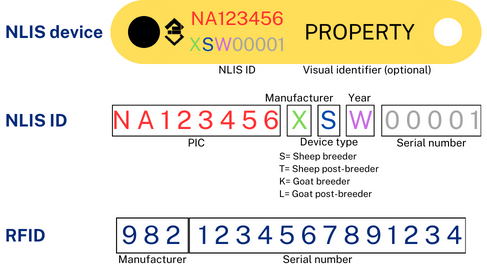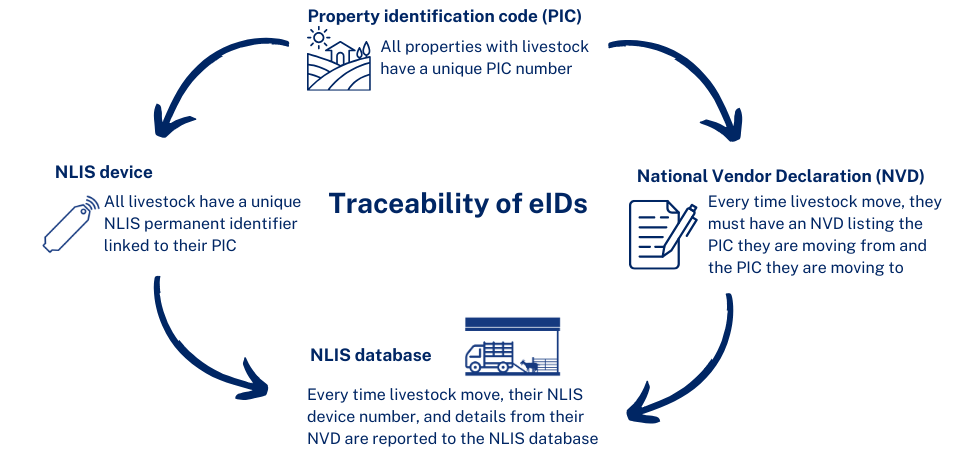What is an eID?
Electronic identification (eID) devices, also called ‘eID devices’ allow individual identification of animals. The devices have a Radio Frequency Identifier (RFID) microchip, which has a distinctive 16-digit internal serial number, also known as an RFID number. When "read" by a handheld wand or panel reader, this RFID number can be electronically recorded. The RFID is linked to an external visual code (NLIS ID) that is the unique visual identifier for the tagged animal. Both the RFID serial number and the NLIS ID are connected in the NLIS database to uniquely identify individual animals.
- The RFID is like the VIN of a car and the external NLIS ID like the numberplate – they both identify and can be used to trace the owner of a vehicle.
Only devices accredited by Integrity Systems/ISC can be used in sheep and goats in NSW for eID purposes.

Why is eID being implemented?
The implementation of electronic identification (eID) in sheep and goats is aimed at enhancing traceability and biosecurity within the livestock industry. eIDs enhance the ability to identify and trace individual food and fibre producing animals and their products by:
- Providing more accurate and timely traceability of animals
- Improving the ability of authorities to respond quickly to disease outbreaks or food safety concerns
- Reducing the number of animals and producers impacted (including animals destroyed) in response to an emergency disease
- Reducing the time that Australia is restricted from export markets following an emergency disease or residue incident.
A 2020 traceability exercise by SAFEMEAT found that only 70% of slaughtered sheep identified with visual tags with the mob-based system could be traced back to the vendor/s or property/s of residence for the previous 30 days, whereas 99.64% of slaughtered sheep with eID could be traced back to the vendor/s or property/s of residence over the same period.
The Victorian eID experience has also shown that traceback now takes a matter of hours, whereas for a visual tag mob-based system it previously took days.
How do eIDs improve traceability?
Electronic identification (eID) enhances traceability by providing a systematic and efficient means of tracking and identifying individual animals throughout their lifecycle, including:
- Individual Identification to precisely track movements of animals between locations.
- Accurate record keeping through the use of a centralised database known as the NLIS database.
- Quick retrieval of information in the event of a disease outbreak or food safety concern.
- Supply chain transparency and improved consumer confidence in the accuracy of information related to the origin and movement of livestock.

This video, “Where’s Woolly”, shows the difference between the current mob-based movement and the mandatory individual eID system we are moving to for sheep and goats.
“Where’s Woolly”, was created by the industry-governments’ co-design group supporting the Sheep and Goat Traceability Taskforce in November 2022.
Who is affected by the transition to sheep and goat eID in NSW?
The introduction of electronic identification (eID) for sheep and goats will affect all individuals and businesses in New South Wales involved in owning or trading one or more sheep or goats.
This includes all owners of sheep and goats such as:
- Pet sheep or goats
- Mobile petting zoos
- Hobby farms
- Commercial sheep and goat producers
This also includes businesses involved in the trading of sheep and goats such as:
- Livestock agents
- Saleyards
- Livestock depots
- Abattoirs
- Knackeries
There are some specific situations where an eID device will not be required, such as:
Sheep and goats that never leave their property of birth: If you have any sheep or goats that never leave their property of birth for any reason, they are not required to have an eID attached. This may be for sheep and goats kept as pets or kept for on-farm processing and consumption. If they leave your property for any reason, such as an emergency trip to the vet, they must have an eID attached.
Harvested rangeland goats: Approved movements of harvested rangeland goats are still able to occur without an eID device as long as the goat(s):
- have been captured from a wild state
- have not been born through managed breeding
- have not been subjected to any animal husbandry procedures or treatments
- are transported direct to a processor for slaughter, or
- are transported direct to one registered depot, and subsequently to processing within 10 days.
If you are unsure about the requirements for using eIDs for your sheep or goats, contact us at sheepgoateid@dpi.nsw.gov.au.
When is sheep and goat eID happening in NSW?
30 June 2024
- Mandatory processor eID scanning and upload
1 January 2025
- Mandatory eID for all sheep and goats born from this date, prior to leaving property of birth
- Mandatory eID scanning and upload by saleyards and depots
- Mandatory eID property to property transfers
1 January 2027
- Mandatory eID for all sheep and goats prior to leaving any property
NSW Implementation Plan
NSW has an implementation plan that provides more detail on why we are moving to eID, what changes will occur as part of the move and what support will be available.
For more details about what you will need to do to be ready when these changes take effect, visit our pages for:
- Livestock owners
- Saleyards and depots
- Processors
- Livestock agents
Where is sheep and goat eID being implemented?
In September 2022, all Commonwealth, State and Territory Agriculture Ministers agreed to work collaboratively with industry towards national mandatory individual electronic identification (eID) of sheep and goats, from 1 January 2025. eID has already been implemented for sheep and goats in Victoria.
More Information and Contact Us
Information on our industry support packages can be found at NSW Sheep and Goat eID Rebate Scheme.
To find out where our team will be delivering information about sheep and goat eID, visit our Upcoming Events page or sign up for our newsletter.
The sheep and goat traceability team has expert staff located around NSW that are available to answer your questions and attend events in your area. Contact us at sheepgoateid@dpi.nsw.gov.au.
